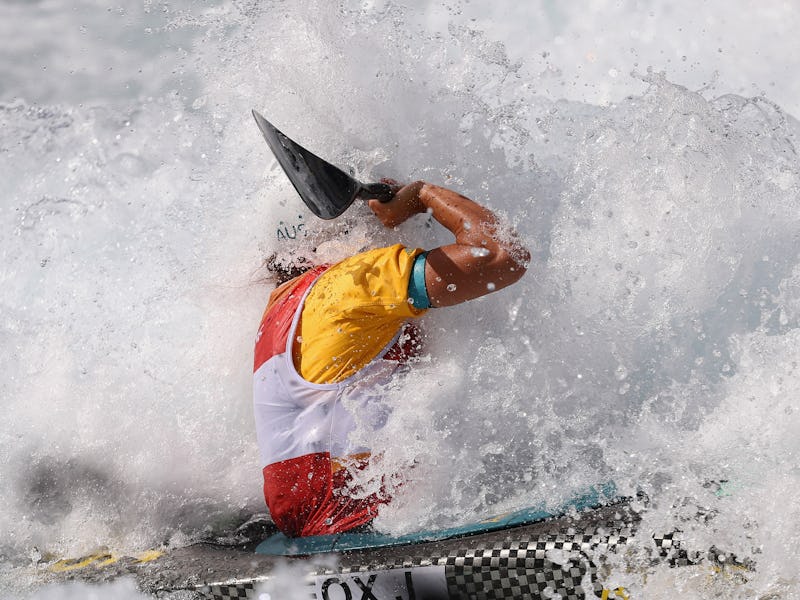The Olympic Whitewater Course Is an Engineering Marvel
Canoe slalom is insane from start to finish.

Once upon a time, whitewater slalom competitions — which encompasses whitewater canoeing and kayaking — were held on natural stretches of whitewater. The rules were (and are) deceptively simple. Athletes have to guide their boats through the colored gates, some going upstream, without touching them. Smashing into a gate is a two-second penalty, missing a gate is a 50-second penalty. The goal is to have the fastest overall time, and you have (at most) 90 seconds to survive 250 meters of raging whitewater.
What started off as a relatively easy sport in terms of setting — just pick a rocky river course and you’re good to go! — has evolved into a sport that required engineering akin to designing a roller coaster-meets-obstacle course that would accurately figure out the best canoeists in the world.
For three of the last five Olympics, two guys have designed the whitewater courses. John Felton was an Olympic slalom canoeist and Bob Campbell used to coach the U.S. whitewater slalom team. Together, they run Whitewater Parks International, which has designed courses in London, Rio de Janeiro, and are working on designing the course for the 2020 Tokyo Olympics.
Canoe slalom has had a rough history in the Olympics. It became a sport in the 1972 Munich Games and got immediately removed, made a comeback for 1992’s Barcelona Games, then got threatened with getting tossed out again in the 2000 Sydney Games when officials couldn’t find an appropriate stretch of rapids for athletes to compete. But slalom athletes weren’t ready to give up on an Olympics, and Felton led the charge in designing a stadium whitewater course, keeping the sport alive.
Building a slalom course is a juggling act of hydraulic engineering, intuition, and legacy building. While designing the course, architects have to make sure that it’s deep enough, that the flow is consistent, and that the eddies and waves are challenging but not too difficult that they become dangerous.
There are a few features all courses must incorporate. An Olympic whitewater course has to be between 200-400 meters long, have between 18-25 gates, and has to take left- and right-handed individuals into account. Channels have to be deep and wide enough to produce waves strong enough to be used in an Olympic competition. Eddies typically exist right behind obstacles, where upstream gates are usually placed.
Beyond the basics, the physics at play in a whitewater course are incredibly dynamic and unpredictable. Waves have underlying eddies and currents, and the positions of the banks and obstacles dramatically shift how the water interacts across the course. There is also the friction within the water, as different currents move at different speeds and rub against each other, changing the dynamics.
David Florence of Great Britain and Richard Hounslow of Great Britain during the Men's Canoe Double.
“For the Olympic athletes there’s definitely a standard that you’re trying to hit that’s kind of ‘you know it when you see it,’” says Campbell. To design this year’s course, Felton and Campbell took the basic requirements provided by the Olympic committee — at least 200 meters long and 0.6 meters deep, except in eddies where the water had to be 1 meter deep — and used their general knowledge of the sport to adjust the channel accordingly.
To further complicate things, Rio officials were invested in trying to decrease the costs of operating a stadium, which meant Felton and Campbell had to be creative and cost-effective. They reduced the distance they had to pump the water for the course by making the gradient of the whitewater less steep. They also decreased the flow from the London course from 15 cubic meters per second to 12 cubic meters per second. The channel is also narrower than previous courses, which allows them to fill it to the necessary depth, but requires less total water. In fact, contrary to the poor water quality in Rio, the pool has the most powerful water filtration system of any whitewater course ever built. So far, it’s been holding out better than the diving pool filter.
Once Campbell and Felton had a general idea of how they wanted the course to work, they sent the designs to the Czech Technical University Hydraulic Laboratory in Prague. There, hydraulic engineers built a scale model of the course to test the flow rate and currents. This allows them to discover any major issues in the course before they actually build it. Since the obstacles are totally adjustable, the difficulty and position of the rapids can be fine tuned first in the model, and then in the full-size stadium.
When designing an Olympic course, the draw is to go for building the biggest, nastiest rapids possible. But the problem with this is it can lead to courses that surge differently for different athletes. “And that’s not comparing apples to apples,” says Campbell. For Rio, the goal was to create a course that was as consistent as possible while still being dynamic.
“In Rio, the whitewater is nonstop — it just goes from top to bottom, straight in the middle of the course,” says Campbell. “If you’re a foot to the right or left, the water is doing something a little different.” This makes for a demanding and technically difficult course that athletes have been raving about since they started running trials on it last November.
Fiona Pennie of Great Britain during the Women's Kayak Semi-final in Rio.
The result is a park that is not only cost-efficient, environmentally friendly, and technically superior to that of many others around the world, but one that Campbell and Felton believe can become an adventure sports park after the Games.
Luuka Jones of New Zealand on her way to cross the finish line and win silver during the Women's Kayak Final.